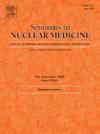PET/CT in Movement Disorders: Update
IF 5.9
2区 医学
Q1 RADIOLOGY, NUCLEAR MEDICINE & MEDICAL IMAGING
引用次数: 0
Abstract
This review synthesizes recent literature, primarily from the last 5 years, to highlight the impact of innovative technologies and analytical approaches on the application of positron emission tomography (PET) in movement disorders. PET remains a cornerstone for investigating these conditions, with recent advancements enhancing our understanding of disease pathophysiology and progression. Established findings, such as the ability of [18F]-fluorodeoxyglucose PET (18F-FDG PET) to differentiate Parkinson's disease (PD) from atypical parkinsonian syndromes based on characteristic metabolic patterns, have been consistently validated. PD typically presents with relative hypermetabolism in the basal ganglia, thalamus and cerebellum, while atypical parkinsonisms exhibit more widespread subcortical hypometabolism. Technological innovations, particularly in quantification methods and metabolic connectivity analysis, have improved diagnostic precision and provided deeper insights into disease mechanisms. Dopaminergic PET imaging, crucial for assessing presynaptic and postsynaptic dysfunction, has also benefited from these advances. The field is further evolving with the development of novel tracers targeting pathological hallmarks, such as alpha-synuclein in PD and multiple system atrophy (MSA), tau in progressive supranuclear palsy (PSP) and cortico-basal degeneration (CBD), and tracers for neuroinflammation, microglial activation, and neurotransmitter systems like serotonin and acetylcholine. While PET is not yet routinely used for the clinical assessment of Huntington's disease or ataxia, research applications are expanding, driven by the potential of these new tracers and analytical techniques. These advancements not only reinforce existing knowledge but also open new avenues for enhancing the understanding and management of movement disorders.
运动障碍的PET/CT:更新。
本文综合了最近5年的文献,重点介绍了创新技术和分析方法对正电子发射断层扫描(PET)在运动障碍中的应用的影响。PET仍然是研究这些疾病的基石,最近的进展增强了我们对疾病病理生理学和进展的理解。已确立的研究结果,如[18F]-氟脱氧葡萄糖PET (18F- fdg PET)基于特征代谢模式区分帕金森病(PD)与非典型帕金森综合征的能力,已得到一致的验证。PD通常表现为基底神经节、丘脑和小脑的相对高代谢,而非典型帕金森则表现为更广泛的皮质下低代谢。技术创新,特别是在量化方法和代谢连通性分析方面的技术创新,提高了诊断精度,并为疾病机制提供了更深入的见解。多巴胺能PET成像对于评估突触前和突触后功能障碍至关重要,也受益于这些进展。随着针对病理标志的新型示踪剂的发展,该领域正在进一步发展,例如PD和多系统萎缩(MSA)中的α -突触核蛋白,进行性核上性麻痹(PSP)和皮质基底变性(CBD)中的tau,以及神经炎症,小胶质细胞激活和神经递质系统(如血清素和乙酰胆碱)的示踪剂。虽然PET尚未常规用于亨廷顿氏病或共济失调的临床评估,但由于这些新的示踪剂和分析技术的潜力,研究应用正在扩大。这些进步不仅加强了现有的知识,而且为加强对运动障碍的理解和管理开辟了新的途径。
本文章由计算机程序翻译,如有差异,请以英文原文为准。
求助全文
约1分钟内获得全文
求助全文
来源期刊

Seminars in nuclear medicine
医学-核医学
CiteScore
9.80
自引率
6.10%
发文量
86
审稿时长
14 days
期刊介绍:
Seminars in Nuclear Medicine is the leading review journal in nuclear medicine. Each issue brings you expert reviews and commentary on a single topic as selected by the Editors. The journal contains extensive coverage of the field of nuclear medicine, including PET, SPECT, and other molecular imaging studies, and related imaging studies. Full-color illustrations are used throughout to highlight important findings. Seminars is included in PubMed/Medline, Thomson/ISI, and other major scientific indexes.
 求助内容:
求助内容: 应助结果提醒方式:
应助结果提醒方式:


